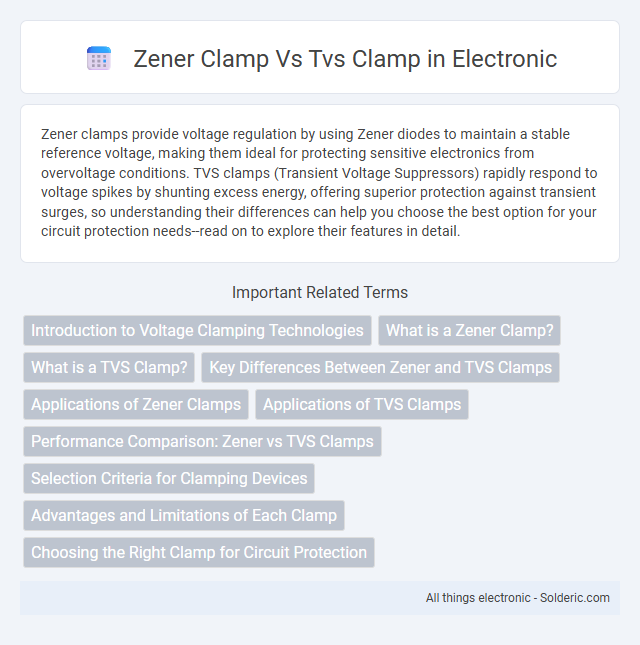Zener clamps provide voltage regulation by using Zener diodes to maintain a stable reference voltage, making them ideal for protecting sensitive electronics from overvoltage conditions. TVS clamps (Transient Voltage Suppressors) rapidly respond to voltage spikes by shunting excess energy, offering superior protection against transient surges, so understanding their differences can help you choose the best option for your circuit protection needs--read on to explore their features in detail.
Comparison Table
| Feature | Zener Clamp | TVS Clamp |
|---|---|---|
| Component Type | Zener diode with series resistor | Transient Voltage Suppressor diode (TVS diode) |
| Primary Function | Voltage regulation and overvoltage protection | Transient overvoltage protection (ESD, surges) |
| Response Time | Slower, limited by diode and resistor | Fast, within picoseconds to nanoseconds |
| Clamping Voltage | Set by Zener breakdown voltage | Specified clamping voltage, lower peak voltage during transients |
| Energy Absorption | Lower energy handling, suitable for steady overvoltage | High energy absorption, designed for transient surges |
| Typical Applications | Voltage reference, voltage limiting in low power circuits | ESD protection, surge suppression in sensitive electronics |
| Durability | Can degrade under repeated stress | Highly robust against repetitive transients |
| Cost | Generally low cost | Moderate cost |
Introduction to Voltage Clamping Technologies
Voltage clamping technologies protect sensitive electronics from voltage spikes by limiting the voltage to a safe level. Zener clamp circuits use Zener diodes to conduct current once the voltage exceeds a specific breakdown threshold, providing a controlled clamping voltage. TVS (Transient Voltage Suppression) clamps respond rapidly to transient events with low clamping voltage and fast recovery, making them ideal for safeguarding your devices against ESD and surge conditions.
What is a Zener Clamp?
A Zener clamp is a voltage protection circuit that uses a Zener diode to limit voltage spikes by clamping the voltage to a predefined level, protecting sensitive components from transient overvoltages. It is designed to conduct current once the voltage exceeds the Zener breakdown voltage, effectively stabilizing your circuit voltage. Unlike TVS clamps, which respond to fast transient surges, Zener clamps provide precise voltage regulation for steady-state or slow-rising voltage conditions.
What is a TVS Clamp?
A TVS clamp uses a Transient Voltage Suppression diode to protect circuits from voltage spikes by rapidly diverting excess energy. This clamp provides fast response times and high surge current capability, making it ideal for safeguarding sensitive electronic components. Understanding how a TVS clamp functions can help you select the best protection for your device against transient voltage events.
Key Differences Between Zener and TVS Clamps
Zener clamps and TVS clamps differ primarily in their voltage regulation and response time characteristics. Zener clamps provide voltage regulation by maintaining a steady voltage once the breakdown voltage is reached, ideal for voltage reference and low-energy clamping. TVS clamps react faster to transient voltage spikes, offering high energy absorption and superior protection against surges and electrostatic discharge, making them suitable for safeguarding sensitive electronic circuits.
Applications of Zener Clamps
Zener clamps are primarily used in low-voltage circuits for voltage regulation and overvoltage protection, especially in signal lines and reference voltage stabilization. They effectively protect sensitive components by limiting voltage spikes to a predetermined level, making them ideal for protecting microcontrollers and analog circuits. Your circuits benefit from Zener clamps when precise voltage clamping is essential to prevent damage from transient voltage surges.
Applications of TVS Clamps
TVS clamps are primarily used in protecting sensitive electronic circuits from transient voltage spikes caused by electrostatic discharge (ESD), lightning surges, and inductive load switching. Their fast response time and high energy absorption capacity make them ideal for safeguarding telecommunications equipment, automotive electronics, and power supplies. Unlike Zener clamps, TVS clamps provide unidirectional or bidirectional voltage clamping with minimal leakage currents, ensuring reliable circuit protection under extreme conditions.
Performance Comparison: Zener vs TVS Clamps
Zener clamps regulate voltage by shunting current through a Zener diode once a specific breakdown voltage is reached, providing precise voltage clamping with slower response times. TVS clamps utilize transient voltage suppression diodes that react almost instantaneously to voltage spikes, offering superior protection against fast transients and surges. Your choice between Zener and TVS clamps should consider the trade-off between response speed and voltage precision based on the specific performance requirements of your circuit.
Selection Criteria for Clamping Devices
When selecting clamping devices, Zener clamps are ideal for low-energy transient voltage suppression due to their precise voltage regulation and fast response time. TVS clamps excel in high-energy surge protection, offering robust clamping capability and superior peak pulse power ratings. Factors such as transient energy capacity, response time, clamping voltage, and application environment determine the appropriate choice between Zener and TVS clamps.
Advantages and Limitations of Each Clamp
Zener clamps offer precise voltage regulation by maintaining a stable reference voltage, making them ideal for protecting sensitive electronics from overvoltage conditions. TVS clamps provide rapid transient voltage suppression and can handle higher energy spikes, ensuring robust protection against electrostatic discharge and lightning surges. Your choice depends on whether you prioritize stable voltage control with Zener clamps or fast, high-energy surge absorption with TVS clamps.
Choosing the Right Clamp for Circuit Protection
Zener clamps offer precise voltage regulation by maintaining a stable reference voltage, making them ideal for low-power circuits requiring voltage stabilization. TVS clamps provide rapid transient voltage suppression, effectively protecting sensitive electronics from ESD and surge events in high-energy environments. Your choice between a zener clamp and a TVS clamp depends on whether steady voltage regulation or fast transient suppression is critical for your circuit protection needs.
zener clamp vs tvs clamp Infographic

 solderic.com
solderic.com